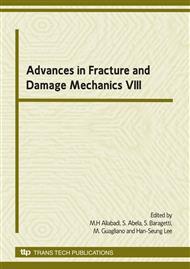[1]
S.Y.N. Chan, G.F. Peng and M. Snson: Fire Behavior of High-Performance Concrete Made with Silica Fume at Various Moisture Contents, ACI Materials Journal (1999), pp.405-411.
DOI: 10.14359/640
Google Scholar
[2]
D. Gawin, F. Pesavento and B.A. Schrefler: Modelling of hygro-thermal behaviour of concrete at high temperature with thermo-chemical and mechanical material degradation, Computer Methods in Applied Mechanics and Engineering, Vol. 192 (2003).
DOI: 10.1016/s0045-7825(03)00200-7
Google Scholar
[3]
R. Tenchev and P. Purnell: An application of a damage constitutive model to concrete at high temperature and prediction of spalling, International Journal of Solids and Structures, Vol. 42 (2005), pp.6550-6565.
DOI: 10.1016/j.ijsolstr.2005.06.016
Google Scholar
[4]
M. Benes and P. Mayer: Coupled Model of Hygro-Thermal Behavior of Concrete during Fire, Journal of Computational and Applied Mathematics, Vol. 218 (2008), pp.12-20.
DOI: 10.1016/j.cam.2007.04.031
Google Scholar
[5]
S.D. Pont, S. Durand and B.A. Schrefler: A Multiphase Thermo-Hydro-Mechanical Model for Concrete at High Temperatures- Finite Element Implementation and Validation under LOCA Load, Nuclear Engineering and Design, Vol. 237 (2007), pp.2137-2150.
DOI: 10.1016/j.nucengdes.2007.03.047
Google Scholar
[6]
M.J. Moran and H.N. Shapiro: Fundamentals of engineering thermodynamics (John Wiley & Sons, INC., USA 2007).
Google Scholar
[7]
G.R. Consolazio, M.C. McVay and J.W. Rish Ⅲ: Measurement and Prediction of Pore Pressures in Saturated Cement Mortar Subjected to Radiant Heating, ACI Materials Journal (1998), pp.525-536.
DOI: 10.14359/395
Google Scholar
[8]
P. Kalifa, F.D. Menneteau and D. Quenard: Spalling and Pore Pressure in HPC at High Temperature, Cement and Concrete Research, Vol. 30 (2000), p.1915-(1927).
DOI: 10.1016/s0008-8846(00)00384-7
Google Scholar
[9]
P. Majumdar and A. Marchertas: Heat, Moisture Transport and Induced Stresses in Porous Materials under Rapid Heating, Numerical Heat Transfer Part A. Vol. 32 (1997), pp.111-130.
DOI: 10.1080/10407789708913883
Google Scholar
[10]
Y. Ichikawa and G.L. England: Prediction of Moisture Migration and Pore Pressure Build-up in Concrete at High Temperatures, Nuclear Engineering and Design, Vol. 228 (2004), p.245259.
DOI: 10.1016/j.nucengdes.2003.06.011
Google Scholar


